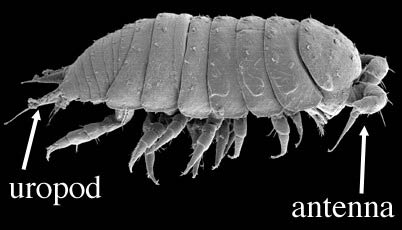- Isopoda
-

Common names: slaters, pillbugs, isopods, sowbugs
Probability of encounter: high
Quarantine importance: tramp species.
Similarity to mites: none.
Normal adult length: 5-15 mm
Body tagmata: head (1 obvious pair of antennae), thorax (7 pairs of legs), abdomen (5 free segments; 1 pair of biramous uropods)
Eyes: compound lateral
Antennae: antennae with < 10 segments; antennules vestigial
Mouthparts: mandibles without palps; two pairs of maxillae
Legs: 7 thoracic pairs
Respiration: abdominal gills and pseudotracheae in basal leg segments
Gonopore: first abdominal segment
Distinguishing features: dorsoventrally compressed; one obvious pair of antennae; 7 pairs of legs and 1 pair of uropods
Comments: The isopod body may be dorso-ventrally flattened, but is often dome-like dorsally and some species can curl into a ball. The second pair of antennae (antennules) are vestigial. The thorax has 7 pairs of legs and the abdomen has a single pair of biramous uropods.